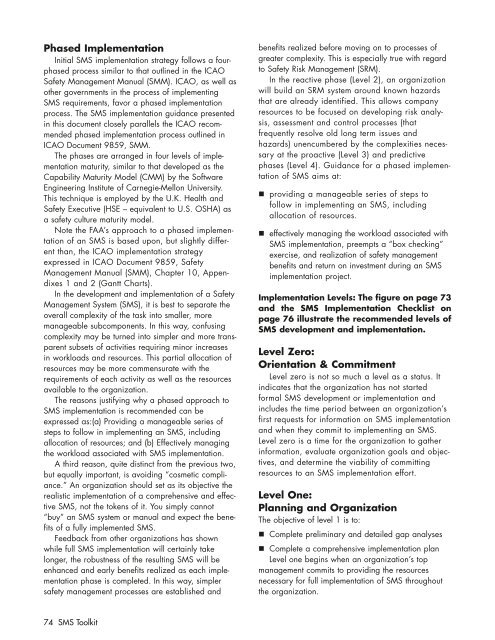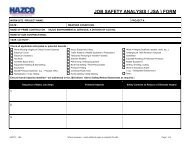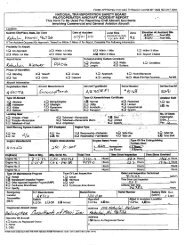International Helicopter Safety Team Safety Management System Toolkit
IHST - Safety Management Toolkit - Skybrary
IHST - Safety Management Toolkit - Skybrary
- No tags were found...
You also want an ePaper? Increase the reach of your titles
YUMPU automatically turns print PDFs into web optimized ePapers that Google loves.
Phased Implementation<br />
Initial SMS implementation strategy follows a fourphased<br />
process similar to that outlined in the ICAO<br />
<strong>Safety</strong> <strong>Management</strong> Manual (SMM). ICAO, as well as<br />
other governments in the process of implementing<br />
SMS requirements, favor a phased implementation<br />
process. The SMS implementation guidance presented<br />
in this document closely parallels the ICAO recommended<br />
phased implementation process outlined in<br />
ICAO Document 9859, SMM.<br />
The phases are arranged in four levels of implementation<br />
maturity, similar to that developed as the<br />
Capability Maturity Model (CMM) by the Software<br />
Engineering Institute of Carnegie-Mellon University.<br />
This technique is employed by the U.K. Health and<br />
<strong>Safety</strong> Executive (HSE – equivalent to U.S. OSHA) as<br />
a safety culture maturity model.<br />
Note the FAA’s approach to a phased implementation<br />
of an SMS is based upon, but slightly different<br />
than, the ICAO implementation strategy<br />
expressed in ICAO Document 9859, <strong>Safety</strong><br />
<strong>Management</strong> Manual (SMM), Chapter 10, Appendixes<br />
1 and 2 (Gantt Charts).<br />
In the development and implementation of a <strong>Safety</strong><br />
<strong>Management</strong> <strong>System</strong> (SMS), it is best to separate the<br />
overall complexity of the task into smaller, more<br />
manageable subcomponents. In this way, confusing<br />
complexity may be turned into simpler and more transparent<br />
subsets of activities requiring minor increases<br />
in workloads and resources. This partial allocation of<br />
resources may be more commensurate with the<br />
requirements of each activity as well as the resources<br />
available to the organization.<br />
The reasons justifying why a phased approach to<br />
SMS implementation is recommended can be<br />
expressed as:(a) Providing a manageable series of<br />
steps to follow in implementing an SMS, including<br />
allocation of resources; and (b) Effectively managing<br />
the workload associated with SMS implementation.<br />
A third reason, quite distinct from the previous two,<br />
but equally important, is avoiding “cosmetic compliance.”<br />
An organization should set as its objective the<br />
realistic implementation of a comprehensive and effective<br />
SMS, not the tokens of it. You simply cannot<br />
“buy” an SMS system or manual and expect the benefits<br />
of a fully implemented SMS.<br />
Feedback from other organizations has shown<br />
while full SMS implementation will certainly take<br />
longer, the robustness of the resulting SMS will be<br />
enhanced and early benefits realized as each implementation<br />
phase is completed. In this way, simpler<br />
safety management processes are established and<br />
benefits realized before moving on to processes of<br />
greater complexity. This is especially true with regard<br />
to <strong>Safety</strong> Risk <strong>Management</strong> (SRM).<br />
In the reactive phase (Level 2), an organization<br />
will build an SRM system around known hazards<br />
that are already identified. This allows company<br />
resources to be focused on developing risk analysis,<br />
assessment and control processes (that<br />
frequently resolve old long term issues and<br />
hazards) unencumbered by the complexities necessary<br />
at the proactive (Level 3) and predictive<br />
phases (Level 4). Guidance for a phased implementation<br />
of SMS aims at:<br />
providing a manageable series of steps to<br />
follow in implementing an SMS, including<br />
allocation of resources.<br />
effectively managing the workload associated with<br />
SMS implementation, preempts a “box checking”<br />
exercise, and realization of safety management<br />
benefits and return on investment during an SMS<br />
implementation project.<br />
Implementation Levels: The figure on page 73<br />
and the SMS Implementation Checklist on<br />
page 76 illustrate the recommended levels of<br />
SMS development and implementation.<br />
Level Zero:<br />
Orientation & Commitment<br />
Level zero is not so much a level as a status. It<br />
indicates that the organization has not started<br />
formal SMS development or implementation and<br />
includes the time period between an organization’s<br />
first requests for information on SMS implementation<br />
and when they commit to implementing an SMS.<br />
Level zero is a time for the organization to gather<br />
information, evaluate organization goals and objectives,<br />
and determine the viability of committing<br />
resources to an SMS implementation effort.<br />
Level One:<br />
Planning and Organization<br />
The objective of level 1 is to:<br />
Complete preliminary and detailed gap analyses<br />
Complete a comprehensive implementation plan<br />
Level one begins when an organization’s top<br />
management commits to providing the resources<br />
necessary for full implementation of SMS throughout<br />
the organization.<br />
74 SMS <strong>Toolkit</strong>







